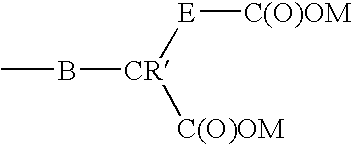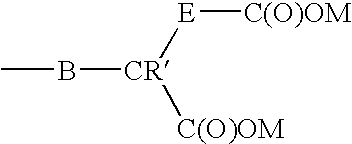Oral care compositions comprising dicarboxy functionalized polyorganosiloxanes
a functionalized polyorganosiloxanes and oral care technology, applied in the field of oral care compositions comprising dicarboxy functionalized polyorganosiloxanes, can solve the problems of inability to achieve the effect of coating the teeth with pdms polymers, constant source of irritation of gingiva, and undesirable appearance to the outside, so as to prevent, reduce or remove plaque, calculus and surface deposited stains, and prolong retention
- Summary
- Abstract
- Description
- Claims
- Application Information
AI Technical Summary
Benefits of technology
Problems solved by technology
Method used
Image
Examples
example 1
Preparation of a Dicarboxy Functionalized Polydimethylsiloxane Having Pendant —(CH2)3—CH(COOH)—CH2COOH Groups
[0116]93.7 g (i.e., 0.67 mol) of allyl succinic anhydride, 52 g of toluene and 1.01 g of a Kardtedt catalyst solution (0.1% of Pt in hexamethyldisiloxane) are added into a 500 ml reactor. The reaction mass is heated at 90° C.; 120 g (i.e., 0.45 mol of SiH) of a polydimethylhydrogenosiloxane having the formula
Me3SiO(SiMe2O)9(SiMeHO)4SiMe3
and containing 3.75 mol of SiH / kg, are added over 3 hours. The SiH amount (determined by gazometry) transformed at the end of the addition is of 96.1%; it is of 100% 2 hours after the end of the addition. The volatiles are eliminated by evaporation under vacuum (3 mbar) over 10 hours at 150° C. 15 g of demineralized water are then added in order to hydrolyze the succinic anhydride functions. The hydrolysis reaction is followed by infra-red analysis (acid band at 1714 cm−1, anhydride band at 1863 and 1782 cm−1). When the hydrolysis reaction is ...
example 2
Preparation of a Dicarboxy Functionalized Polydimethylsiloxane Having Pendant —(CH2)3—CH(COOH)—CH2COOH Groups
[0118]49.8 g (i.e., 0.36 mol) of allyl succinic anhydride, 44 g of toluene and 1.139 g of a Kardtedt catalyst solution (0.1% of Pt in hexamethyldisiloxane) are added into a 500 ml reactor. The reaction mass is heated at 90° C.; 150.3 g (i.e., 0.266 mol of SiH) of a polydimethylhydrogenosiloxane having the formula
Me3SiO(SiMe2O)100(SiMeHO)15SiMe3
and containing 1.77 mol of SiH / kg, are added over 1 hour. The SiH amount (determined by gazometry) transformed at the end of the addition is of 86%; it is of 100% 16 hours after the end of the addition. The volatiles are eliminated by evaporation under vacuum (6 mbar) over 10 hours at 150° C. 101 g of toluene are added; the reaction mass is filtered. 6.7 g of demineralized water are then added in order to hydrolyze the succinic anhydride functions. The hydrolysis reaction is followed by infrared analysis (acid band at 1714 cm−1, anhydri...
example 3
Retention of Functionalized Siloxane Polymers Applied as a 1% Solution on Polished Bovine Enamel Surfaces
[0120]The deposition and retention of dicarboxy functionalized siloxane polymers according to the present invention applied as a 1% solution on polished bovine enamel surfaces are compared with other siloxane polymers containing other functional groups. Solutions of the different siloxane polymers were prepared at 1% concentration in MIBK (methyl isobutyl ketone). Six □l of each solution was applied directly to clean, polished bovine enamel specimens set in resin, having approximately 1 cm2 surface area. The solvent was allowed to evaporate under ambient conditions and an initial water contact angle (WCA) was measured using a Kruss DSA-10 system. The enamel specimens were then soaked in ultra pure water for 5 minutes, and after allowing to air dry the water contact angle was re-measured. Then, the specimens were brushed on a brushing machine (V-8 crossover with an Oral-B flat hea...
PUM
| Property | Measurement | Unit |
|---|---|---|
| temperature | aaaaa | aaaaa |
| temperature | aaaaa | aaaaa |
| temperature | aaaaa | aaaaa |
Abstract
Description
Claims
Application Information
 Login to View More
Login to View More - R&D
- Intellectual Property
- Life Sciences
- Materials
- Tech Scout
- Unparalleled Data Quality
- Higher Quality Content
- 60% Fewer Hallucinations
Browse by: Latest US Patents, China's latest patents, Technical Efficacy Thesaurus, Application Domain, Technology Topic, Popular Technical Reports.
© 2025 PatSnap. All rights reserved.Legal|Privacy policy|Modern Slavery Act Transparency Statement|Sitemap|About US| Contact US: help@patsnap.com


